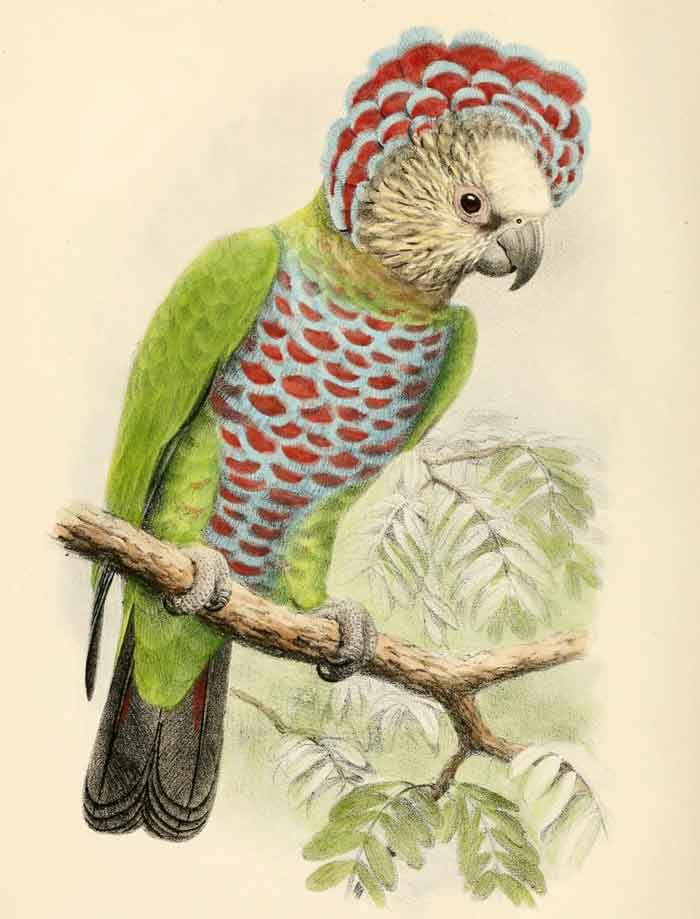
Deroptyus accipitrinus (Information about this image)
Superregnum: Eukaryota
Regnum: Animalia
Subregnum: Eumetazoa
Cladus: Bilateria
Cladus: Nephrozoa
Superphylum: Deuterostomia
Phylum: Chordata
Subphylum: Vertebrata
Infraphylum: Gnathostomata
Megaclassis: Osteichthyes
Cladus: Sarcopterygii
Cladus: Rhipidistia
Cladus: Tetrapodomorpha
Cladus: Eotetrapodiformes
Cladus: Elpistostegalia
Superclassis: Tetrapoda
Cladus: Reptiliomorpha
Cladus: Amniota
Classis: Reptilia
Cladus: Eureptilia
Cladus: Romeriida
Subclassis: Diapsida
Cladus: Sauria
Infraclassis: Archosauromorpha
Cladus: Crurotarsi
Divisio: Archosauria
Cladus: Avemetatarsalia
Cladus: Ornithodira
Subtaxon: Dinosauromorpha
Cladus: Dinosauriformes
Cladus: Dracohors
Cladus: Dinosauria
Ordo: Saurischia
Cladus: Eusaurischia
Cladus: Theropoda
Cladus: Neotheropoda
Cladus: Averostra
Cladus: Tetanurae
Cladus: Avetheropoda
Cladus: Coelurosauria
Cladus: Tyrannoraptora
Cladus: Maniraptoromorpha
Cladus: Maniraptoriformes
Cladus: Maniraptora
Cladus: Pennaraptora
Cladus: Paraves
Cladus: Eumaniraptora
Cladus: Avialae
Infraclassis: Aves
Cladus: Euavialae
Cladus: Avebrevicauda
Cladus: Pygostylia
Cladus: Ornithothoraces
Cladus: Euornithes
Cladus: Ornithuromorpha
Cladus: Ornithurae
Cladus: Carinatae
Parvclassis: Neornithes
Cohors: Neognathae
Cladus: Neoaves
Cladus: Telluraves
Cladus: Australaves
Ordo: Psittaciformes
Familia: Psittacidae
Subfamilia: Arinae
Tribus: Arini
Genus: Deroptyus
Species: Deroptyus accipitrinus
Name
Deroptyus accipitrinus (Linnaeus, 1758)
Synonyms
Psittacus accipitrinus (protonym)
References
Linnaeus, C. 1758. Systema Naturae per regna tria naturae, secundum classes, ordines, genera, species, cum characteribus, differentiis, synonymis, locis. Editio Decima, Reformata. Tomus I. Holmiæ (Stockholm): impensis direct. Laurentii Salvii. 824 pp. DOI: 10.5962/bhl.title.542 [first availability: page 102] BHL Reference page.
Vernacular names
čeština: Papoušek vějířový
Deutsch: Fächerpapagei
English: Red-fan Parrot
español: Loro cacique, quinaquina
suomi: Haukka-aratti
français: Papegeai maillé
magyar: Legyezőpapagáj
italiano: Pappagallo dal ventaglio
Nederlands: Kraagpapegaai
português: Anacã
русский: Веерный попугай
slovenčina: Anaka
svenska: Hökhuvudpapegoja

The red-fan parrot (Deroptyus accipitrinus), also known as the hawk-headed parrot, is an unusual New World parrot hailing from the Amazon Rainforest. It is the only member of the genus Deroptyus.
It dwells in Brazil, Suriname, Bolivia, Ecuador, Colombia, areas of northeast Peru, Venezuela, French Guiana and Guyana.
Description
The red-fan parrot possesses elongated neck feathers that can be raised to form an elaborate fan, which greatly increases the bird's apparent size, and is possibly used when threatened. It generally lives in undisturbed forest, feeding in the canopy on fruits. It has a dark brown face with white streaks, bare black patch round its brown eye, green wings, flanks and tail and red and blue barred breast.
Behavior
The bird nests in holes in trees and stumps. Two to three eggs are normally laid, hatching after approximately 26 days.[2] The young start to fledge in the wild at approximately 10 weeks old.[2] Only two nests have been examined in the wild, both had one chick.
It is not considered threatened, but is listed on CITES Appendix II (as are most parrots not listed on Appendix I).
Aviculture
Red-fan parrots, although not particularly common in aviculture, are sometimes kept as aviary birds or companion parrots. While juvenile birds tend to be docile, adults can be particularly ill-tempered, stubborn, unpredictable and strong-willed birds, showing extreme aggression towards humans and other birds housed with them (including others of their own species and/or their own mates), particularly when in breeding condition. Red-fan parrots, when kept as pets tend to bond with one person and require firm handling and a patient owner, experienced in both bird-keeping and the reading of parrot body language. However, as with all parrots, temperament can vary greatly from individual to individual and some red-fan parrots make excellent companions.[3][4][5][6]
Retrieved from "http://en.wikipedia.org/"
All text is available under the terms of the GNU Free Documentation License



